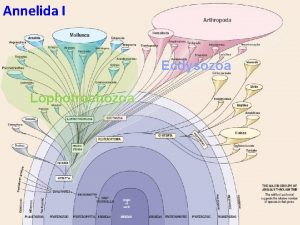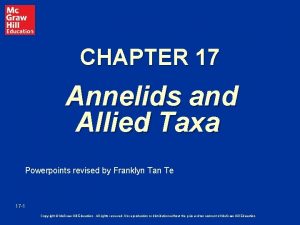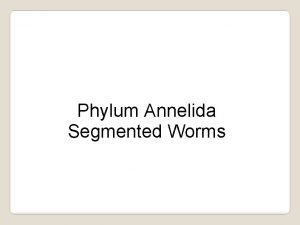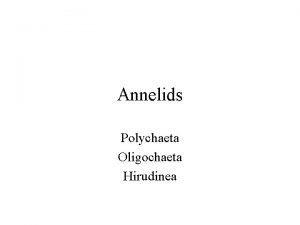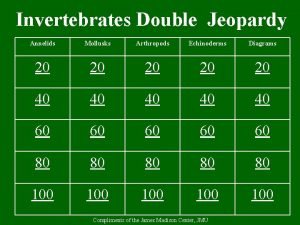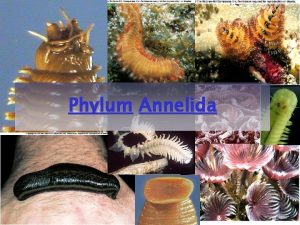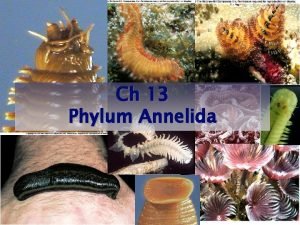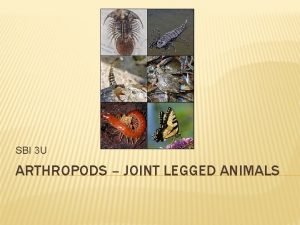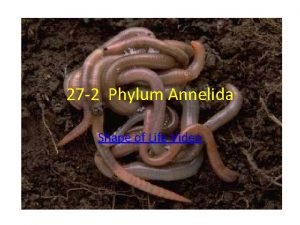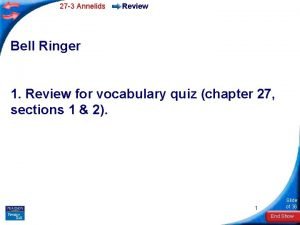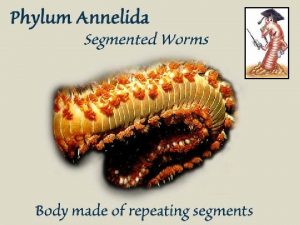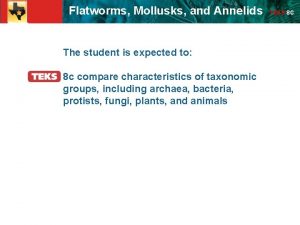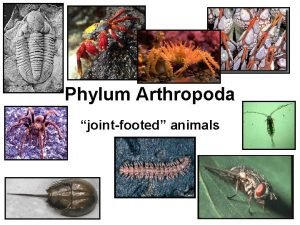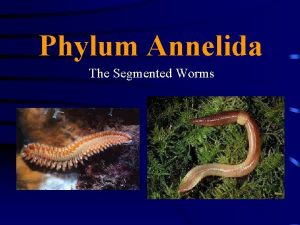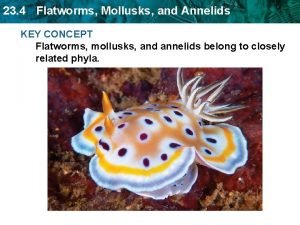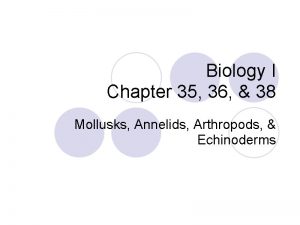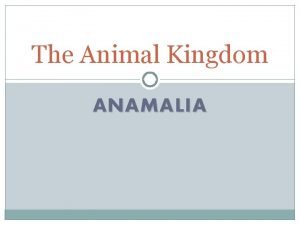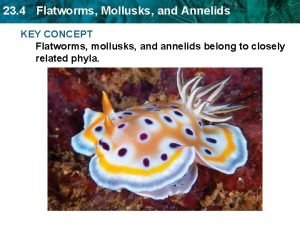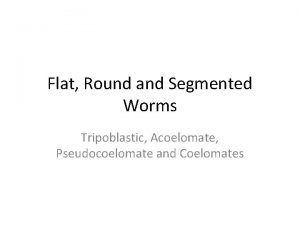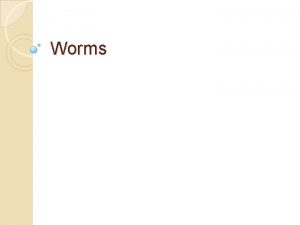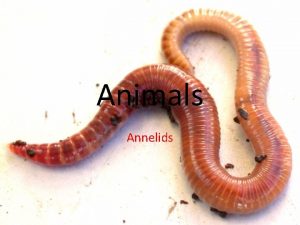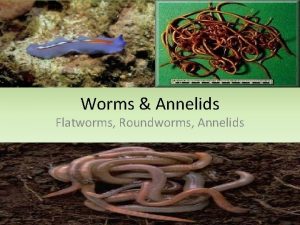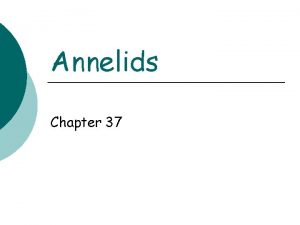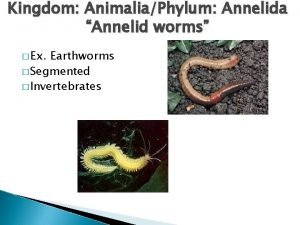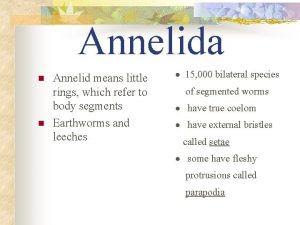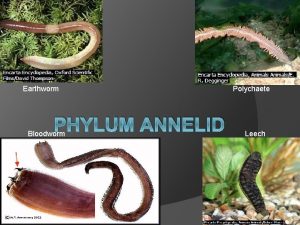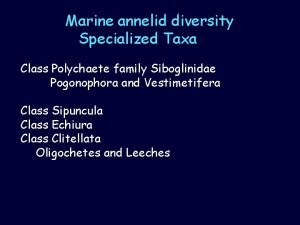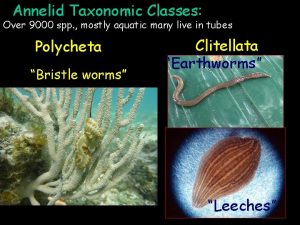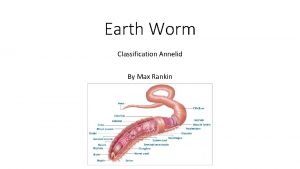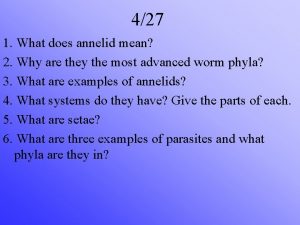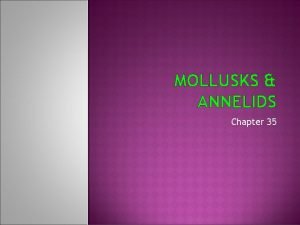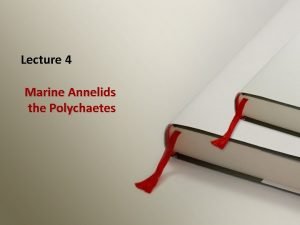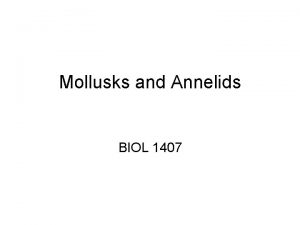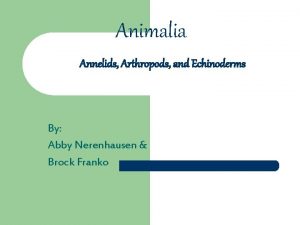ANNELIDS ANNELIDS WHAT IS AN ANNELID What Is























- Slides: 23

ANNELIDS

ANNELIDS

WHAT IS AN ANNELID? • What Is an Annelid? • Annelids are worms with segmented bodies. They have a true coelom that is lined with tissue derived from mesoderm. Copyright Pearson Prentice Hall

WHAT IS AN ANNELID? • Three Germ Layers of an Annelid

WHAT IS AN ANNELID? • The body of an annelid is divided into segments. • Each segment is separated by septum, which are internal walls between each segment. Copyright Pearson Prentice Hall

WHAT IS AN ANNELID? • Body segments may carry eyes, antennae, other sense organs, or be specialized for functions such as respiration. • Bristles called setae may be attached to each segment. • Annelids have a tube-within-a-tube digestive tract that food passes through from the mouth to the anus. Copyright Pearson Prentice Hall

FORM AND FUNCTION IN ANNELIDS • Form and Function in Annelids • Annelids have complex organ systems. • Many of these systems are unique because of the segmented body plan of this group. Copyright Pearson Prentice Hall

DIGESTION • Feeding and Digestion • In carnivorous species, the pharynx usually holds two or more sharp jaws that are used to attack prey. -Leeches • Annelids that feed on decaying vegetation have a pharynx covered with sticky mucus. -Earthworms Copyright Pearson Prentice Hall

DIGESTION • In earthworms, the pharynx pumps food and soil from the mouth into the esophagus. • The food then moves through the crop, where it can be stored. • It then moves through the gizzard, where it is ground into smaller pieces. • Finally into the intestine for nutrients to be absorbed

CIRCULATION! • Annelids typically have a closed circulatory system, in which blood is contained within a network of blood vessels. • Dorsal Vessel • Blood moves towards head • Ventral Vessel • Blood moves away from head • 5 Pumping organs (aortic arches) • Acts like your heart, to pump blood around worm

RESPIRATION • Aquatic annelids often breathe through gills. • An organ specialized for exchange of gases underwater. • Land-dwelling annelids take in oxygen and give off carbon dioxide through their moist skin. Diffusion • These animals secrete mucus to keep skin moist, for better diffusion!

EXCRETION • Digestive wastes pass through anus • Cellular wastes (nitrogen) is eliminated by nephridia • Nephridia are excretory organs that filter fluid in the coelom. Nephridia

NERVOUS SYSTEM • Most annelids have a well-developed nervous system consisting of a brain and several nerve cords. • Aquatic annelids have best developed sense organs • Sensory tentacles, chemical receptors, eyes, and statocysts (gravity) Brain Ganglia Nerve collar

MOVEMENT • Annelids have two groups of body muscles that function as part of a hydrostatic skeleton. • Longitudinal muscles • Run from anterior to posterior • Contact to make the worn short and fat • Circular muscles • Wrap around body • Contract to make the worm long and skinny • Setae are used to keep worm in place while contracting muscles

REPRODUCTION • Most annelids reproduce sexually. • Earthworms are hermaphrodites. Two worms attach to each other, exchange sperm, and then store the sperm in special sacs.

REPRODUCTION • A clitellum is a band of thickened, specialized segments that secrete mucus when eggs are ready. • Eggs and sperm are released here, and fertilized • Generally not self fertilized • After eggs are fertilized in the ring, the ring slips off the worm's body and forms a protective cocoon. • Young worms hatch weeks later.

REPRODUCTION • Asexual Reproduction • Sometimes seen in Oligochaetes and Polychaetes • Oligochaetes will sometimes regrow from segments of their body • Polychaetes will often use budding as a form of reproduction

GROUPS OF ANNELIDS • Annelids are divided into three classes • Oligochaetes • Leeches • Polychaetes

GROUPS OF ANNELIDS • Oligochaetes contains earthworms and their relatives. • Oligochaetes typically have streamlined bodies and relatively few setae compared to polychaetes. Most oligochaetes live in soil or fresh water.

GROUPS OF ANNELIDS • Leeches • The class Hirudinea contains the leeches. • Leeches are typically external parasites that suck the blood and body fluids of their host. • https: //www. youtube. com/watch? v=5 IVmwg 59 MXY Copyright Pearson Prentice Hall

GROUPS OF ANNELIDS • Polychaetes are marine annelids that have paired, paddlelike appendages tipped with setae. • The setae are brushlike structures on the worm.

ECOLOGY OF ANNELIDS • Earthworms • Aerate soil, so roots get oxygen (2 m) • Tunnels provide passageways for roots • Bring plant matter down into soil • Eat it, digest it, and mix it with bacteria • Feces rich in nitrogen and micronutrients • Important in diets of birds, moles, toads, snakes. • Marine • Larvea are part of the plankton group • Food chains • “stir up” marine sediment

 Aceolomates
Aceolomates Teloblastic growth
Teloblastic growth Annelid body plan
Annelid body plan How many setae are on each segment of the earthworm
How many setae are on each segment of the earthworm Phylum
Phylum Oligochaeta examples
Oligochaeta examples List the defining characteristics for each class of annelid
List the defining characteristics for each class of annelid Oligochaeta
Oligochaeta What is an annelid
What is an annelid Annuli in annelids
Annuli in annelids Joint-legged
Joint-legged Shape of life videos
Shape of life videos Section 27-3 annelids
Section 27-3 annelids Excretory organ of annelids
Excretory organ of annelids Annelida classes
Annelida classes Section 4 flatworms mollusks and annelids
Section 4 flatworms mollusks and annelids Subphylum
Subphylum Annelida characteristics
Annelida characteristics Section 4 flatworms mollusks and annelids
Section 4 flatworms mollusks and annelids Do echinoderms have cephalization
Do echinoderms have cephalization Are echinoderms warm or cold blooded
Are echinoderms warm or cold blooded Reviewing key concepts: flatworms, annelids, and roundworms
Reviewing key concepts: flatworms, annelids, and roundworms Lobster phylum
Lobster phylum Annelida acoelomate
Annelida acoelomate

